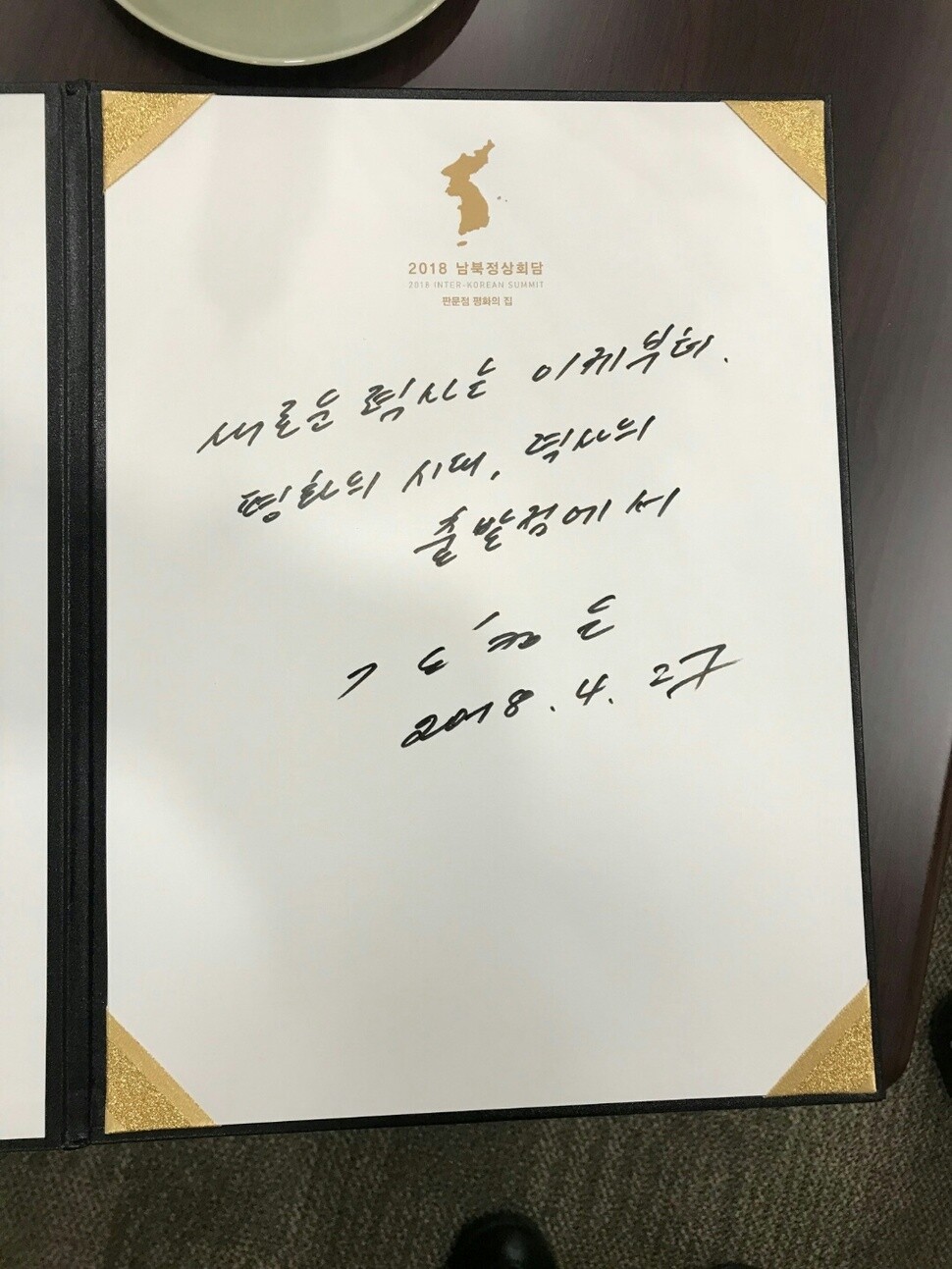hankyoreh
Links to other country sites 다른 나라 사이트 링크
“Panmunjeom Declaration” to be announced following summit

South Korean President Moon Jae-in and North Korea leader Kim Jong-in are scheduled to draft and announce an agreement on major issues including denuclearization of the Korean Peninsula and establishment of permanent peace through two 2018 inter-Korean summits on the morning and afternoon of Apr. 27, the Blue House announced on Apr. 26.
“Once the summits are over, there is scheduled to be an agreement signing and announcement,” Presidential Chief of Staff and inter-Korean summit preparation committee chairman Im Jong-seok said in a briefing that day from the main press center at the Korea International Exhibition Center (KINTEX) in Ilsan, Gyeonggi Province.
“We would like to have an official announcement as much as possible to communicate things distinctly, but the format and setting are to be determined according to the level of agreement,” Im said.
“That part is currently undecided,” he added.
When asked by reporters for the title of the written document containing the terms agreed upon by Moon and Kim, Im replied, “I hope it will be the ‘Panmunjeom Declaration.’”
The “Panmunjeom Declaration” is expected to include content related to all three of the main agenda items for the inter-Korean summit: denuclearization of the Korean Peninsula, establishment of permanent peace, and advancement of inter-Korean relations.
“In general, what the press has been discussing is supposed to be on the agenda,” Im said, adding that it was “not up to us [the summit’s organizers] what the level of expression will be in terms of the language.” His message was that the written terms would be agreed upon and decided in discussions by the two leaders.
Denuclearization is predicted to be the thorniest of the key agenda items the two leaders discuss. Since Kim announced his denuclearization commitment to a South Korean special envoy’s delegation in March, a decision was made at an Apr. 21 Korean Workers’ Party Central Committee plenary session to close down the nuclear test site at Punggye Village and suspend nuclear testing and intercontinental ballistic missile (ICBM) test launches. More advanced measures related to the North’s “past” nuclear program are seen as very likely to be left for the upcoming North Korea-US summit.
“An agreement on denuclearization reached now that North Korea’s nuclear [weapons] and ICBMs have achieved a high level of advancement would be fundamentally different in character from the denuclearization agreements reached in the early 1990s and early 2000s,” Im said.
“That is what will make this summit so tough,” he admitted.
“Things like what level of agreement the two leaders will reach on the denuclearization commitment expressed during the special envoy delegation’s Pyongyang visit or what kind of wording will be used to stipulate it in writing are going to be difficult.”
In contrast, comparatively major progress is seen as likely to occur for the establishment of a permanent peace and advancement of inter-Korean relations. The two sides have already reportedly bridged differences substantially on the terms of a roadmap for declaring an end to the post-Korean War armistice and Cold War system and adopting a peace regime in its stead.
The agreement text is also expected to include content on the establishment of a joint inter-Korean liaison office at Panmunjeom as agreed upon at high-level inter-Korean talks during the Roh Tae-woo administration in 1992, and the peaceful use of the Demilitarized Zone (DMZ) for purposes such as implementing the Park Geun-hye administration’s ambitious plan for a “DMZ world peace park.”
Other areas that may be included in the “Panmunjeom Declaration” are the institution of regular inter-Korean summits, reunions among divided family members, expansion of inter-Korean economic exchange and cooperation once sanctions against North Korea have been eased, resumption of operations at the Kaesong Industrial Complex and tourism at Mt. Keumgang, and exchanges in the areas of society, culture, arts, and sports.
By Kim Kyu-nam and Kim Bo-hyeop, staff reporters
Please direct questions or comments to [english@hani.co.kr]

Editorial・opinion
![[Column] Park Geun-hye déjà vu in Yoon Suk-yeol [Column] Park Geun-hye déjà vu in Yoon Suk-yeol](https://flexible.img.hani.co.kr/flexible/normal/500/300/imgdb/original/2024/0424/651713945113788.jpg) [Column] Park Geun-hye déjà vu in Yoon Suk-yeol
[Column] Park Geun-hye déjà vu in Yoon Suk-yeol![[Editorial] New weight of N. Korea’s nuclear threats makes dialogue all the more urgent [Editorial] New weight of N. Korea’s nuclear threats makes dialogue all the more urgent](https://flexible.img.hani.co.kr/flexible/normal/500/300/imgdb/original/2024/0424/7317139454662664.jpg) [Editorial] New weight of N. Korea’s nuclear threats makes dialogue all the more urgent
[Editorial] New weight of N. Korea’s nuclear threats makes dialogue all the more urgent- [Guest essay] The real reason Korea’s new right wants to dub Rhee a founding father
- [Column] ‘Choson’: Is it time we start referring to N. Korea in its own terms?
- [Editorial] Japan’s rewriting of history with Korea has gone too far
- [Column] The president’s questionable capacity for dialogue
- [Column] Are chaebol firms just pizza pies for families to divvy up as they please?
- [Column] Has Korea, too, crossed the Rubicon on China?
- [Correspondent’s column] In Japan’s alliance with US, echoes of its past alliances with UK
- [Editorial] Does Yoon think the Korean public is wrong?
Most viewed articles
- 1‘We must say no’: Seoul defense chief on Korean, USFK involvement in hypothetical Taiwan crisis
- 2N. Korean delegation’s trip to Iran shows how Pyongyang is leveraging ties with Moscow
- 3‘Weddingflation’ breaks the bank for Korean couples-to-be
- 4[Reportage] On US campuses, student risk arrest as they call for divestment from Israel
- 5Amnesty notes ‘erosion’ of freedom of expression in Korea in annual human rights report
- 6[Column] Park Geun-hye déjà vu in Yoon Suk-yeol
- 7Korea sees more deaths than births for 52nd consecutive month in February
- 8[Editorial] New weight of N. Korea’s nuclear threats makes dialogue all the more urgent
- 9Will NewJeans end up collateral damage in internal feud at K-pop juggernaut Hybe?
- 10[Guest essay] The real reason Korea’s new right wants to dub Rhee a founding father